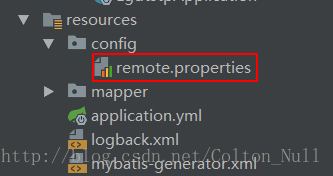这篇文章将为大家详细讲解有关在SpringBoot下如何读取自定义properties配置文件,小编觉得挺实用的,因此分享给大家做个参考,希望大家阅读完这篇文章后可以有所收获。
SpringBoot工程默认读取application.properties配置文件。如果需要自定义properties文件,如何读取呢?
一、在resource中新建.properties文件
在resource目录下新建一个config文件夹,然后新建一个.properties文件放在该文件夹下。如图remote.properties所示

二、编写配置文件
remote.uploadFilesUrl=/resource/files/
remote.uploadPicUrl=/resource/pic/三、新建一个配置类RemoteProperties.java
@Configuration
@ConfigurationProperties(prefix = "remote", ignoreUnknownFields = false)
@PropertySource("classpath:config/remote.properties")
@Data
@Component
public class RemoteProperties {
private String uploadFilesUrl;
private String uploadPicUrl;
}其中
@Configuration 表明这是一个配置类
@ConfigurationProperties(prefix = "remote", ignoreUnknownFields = false) 该注解用于绑定属性。prefix用来选择属性的前缀,也就是在remote.properties文件中的“remote”,ignoreUnknownFields是用来告诉SpringBoot在有属性不能匹配到声明的域时抛出异常。
@PropertySource("classpath:config/remote.properties") 配置文件路径
@Data 这个是一个lombok注解,用于生成getter&setter方法,详情请查阅lombok相关资料
@Component 标识为Bean
四、如何使用?
在想要使用配置文件的方法所在类上表上注解EnableConfigurationProperties(RemoteProperties.class)
并自动注入
@Autowired
RemoteProperties remoteProperties;在方法中使用 remoteProperties.getUploadFilesUrl()就可以拿到配置内容了。
@EnableConfigurationProperties(RemoteProperties.class)
@RestController
public class TestService{
@Autowired
RemoteProperties remoteProperties;
public void test(){
String str = remoteProperties.getUploadFilesUrl();
System.out.println(str);
}
}这里str就是配置文件中的”/resource/files/”了。
PS:下面看下 Spring-boot中读取config配置文件的两种方式
了解过spring-Boot这个技术的,应该知道Spring-Boot的核心配置文件application.properties,当然也可以通过注解自定义配置文件的信息。
Spring-Boot读取配置文件的方式:
一.读取核心配置文件信息application.properties的内容
核心配置文件是指在resources根目录下的application.properties或application.yml配置文件,读取这两个配置文件的方法有两种,都比较简单。
核心配置文件application.properties内容如下:
test.msg=Hello World SpringBoot方式一:使用@Value方式(常用)
package Solin.controller;
import org.springframework.beans.factory.annotation.Value;
import org.springframework.web.bind.annotation.RequestMapping;
import org.springframework.web.bind.annotation.RestController;
@RestController
public class WebController {
@Value("${test.msg}")
private String msg;
@RequestMapping("/index1")
public String index1(){
return "方式一:"+msg;
}
}注意:在@Value的${}中包含的是核心配置文件中的键名。在Controller类上加@RestController表示将此类中的所有视图都以JSON方式显示,类似于在视图方法上加@ResponseBody。
访问:http://localhost:8088/index1时得到:"方式一:Hello World SpringBoot"
方式二:使用Environment方式
package Solin.controller;
import org.springframework.beans.factory.annotation.Autowired;
import org.springframework.beans.factory.annotation.Value;
import org.springframework.core.env.Environment;
import org.springframework.web.bind.annotation.RequestMapping;
import org.springframework.web.bind.annotation.RestController;
@RestController
public class WebController {
@Autowired
private Environment env;
@RequestMapping("/index2")
public String index2(){
return "方式二:"+env.getProperty("test.msg");
}
}注意:这种方式是依赖注入Evnironment来完成,在创建的成员变量private Environment env上加上@Autowired注解即可完成依赖注入,然后使用env.getProperty("键名")即可读取出对应的值。
访问:http://localhost:8088/index2时得到:"方式二:Hello World SpringBoot"
二.读取自定义配置文件信息,例如:author.properties
为了不破坏核心文件的原生态,但又需要有自定义的配置信息存在,一般情况下会选择自定义配置文件来放这些自定义信息,这里在resources目录下创建配置文件author.properties
resources/author.properties内容如下:
author.name=Solin
author.age=22创建管理配置的实体类:
package Solin.controller;
import org.springframework.boot.context.properties.ConfigurationProperties;
import org.springframework.context.annotation.Configuration;
import org.springframework.stereotype.Component;
//加上注释@Component,可以直接在其他地方使用@Autowired来创建其实例对象
@Component
@ConfigurationProperties(prefix = "author",locations = "classpath:author.properties")
public class MyWebConfig{
private String name;
private int age;
public String getName() {
return name;
}
public void setName(String name) {
this.name = name;
}
public int getAge() {
return age;
}
public void setAge(int age) {
this.age = age;
}
}注意:
在@ConfigurationProperties注释中有两个属性:
locations:指定配置文件的所在位置
prefix:指定配置文件中键名称的前缀(我这里配置文件中所有键名都是以author.开头)
使用@Component是让该类能够在其他地方被依赖使用,即使用@Autowired注释来创建实例。
创建测试Controller
package Solin.controller;
import org.springframework.beans.factory.annotation.Autowired;
import org.springframework.stereotype.Controller;
import org.springframework.web.bind.annotation.RequestMapping;
import org.springframework.web.bind.annotation.ResponseBody;
@Controller
public class ConfigController {
@Autowired
private MyWebConfig conf;
@RequestMapping("/test")
public @ResponseBody String test() {
return "Name:"+conf.getName()+"---"+"Age:"+conf.getAge();
}
}注意:由于在Conf类上加了注释@Component,所以可以直接在这里使用@Autowired来创建其实例对象。
访问:http://localhost:8088/test时得到:"Name:Solin---Age:22"
关于“在SpringBoot下如何读取自定义properties配置文件”这篇文章就分享到这里了,希望以上内容可以对大家有一定的帮助,使各位可以学到更多知识,如果觉得文章不错,请把它分享出去让更多的人看到。
亿速云「云服务器」,即开即用、新一代英特尔至强铂金CPU、三副本存储NVMe SSD云盘,价格低至29元/月。点击查看>>
免责声明:本站发布的内容(图片、视频和文字)以原创、转载和分享为主,文章观点不代表本网站立场,如果涉及侵权请联系站长邮箱:is@yisu.com进行举报,并提供相关证据,一经查实,将立刻删除涉嫌侵权内容。